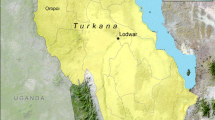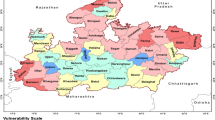Abstract
In this article, we analyze the effects of drought on Ethiopian rural households' food security and associated risk management strategies. Severe droughts have led to a significant depression of crop yields and death of livestock in the past. Droughts have drastically increased the proportion of food-insecure households and lengthened the duration of food insecurity in the area. Ex-ante adaptation strategies widely practised in the area include storage of crop residues as fodder for livestock, rearing of drought tolerant livestock, mixed cropping, use of short-duration crop varieties, and adoption of soil and water conservation practices. Ex-post coping strategies utilized by households include sale of assets and reliance on support from informal networks. Training farmers in the production and conservation of livestock fodder as well as in soil and water conservation practices appear to be key options relevant to strengthen farmers’ capacity to adapt to and cope with drought.
Similar content being viewed by others
Notes
Peasant Association is the smallest administrative unit in Ethiopia.
The DCSI has foundations in the Coping Strategy Index (CSI) developed by CARE and World Food Programme (WFP). The CSI combined both income and consumption strategies into one index to measure household food security and the impact of food aid programmes. The index was used in countries like Uganda, Zimbabwe, Ethiopia and Ghana (CARE/WFP, 2003; Maxwell et al, 2003; Collins, 2004). A detailed procedure of computing CSI is contained in CARE/WFP (2003).
Elevation (Sub-basin): Elevation and rainfall are the main criteria for sub-basin classification (c.f Taddese et al, 2001; Halcrow (1989) cited in Wagnew, 2004). In general, the uplands receive higher amounts of rainfall than the Upper Valley sub-basin, making them more suitable for crop production.
Livestock feed and water reliability: Livestock is an integral part of livelihoods in Ethiopia (Hellmuth et al, 2007). Drought usually affects livestock production via feed and water shortages characterized by grazing inadequacies and drying of water sources (IFAD, 2009). In order to assess drought resilience in terms of the two variables (feed and water availability), relative differences (percentage changes) for each variable between normal and drought year were calculated. PAs exhibiting smaller percentages for each variable are assumed to be more resilient to drought than those with higher percentage changes.
The decision rule was to select one drought with the highest severity score in each PA. In cases of several equal severities, the most recent event (in year 2000 or later) with a severity score equal or greater than 3 were selected because recent drought events could be remembered easily by the respondents. The severity scoring and decision rule were adapted from Keil (2004).
Peasant leaders were asked to provide an estimate of the proportion of households affected by each drought effect in their respective PAs.
Borena Breeds are those that have been bred to adapt to dry areas – adaptable to low plane of nutrition. Borena is named after an area in Ethiopia, which is typically dry.
References
Benhin, J.K.A. (2006) Climate change and South Africa agriculture: Impacts and adaptation options. Pretoria, South Africa: University of Pretoria, Centre for Environmental Economics and Policy in Africa. CEEPA Discussion Paper No. 21.
Boko, M. et al (2007) Africa. In: M.L. Parry, O.F. Canziani, J.P. Palutikof, P.J. van der Linden and C.E. Hanson (eds.) Climate Change 2007: Impacts, Adaptation and Vulnerability. Contribution of Working Group II to the Fourth Assessment Report of the Intergovernmental Panel on Climate Change. Cambridge, UK: Cambridge University Press, pp. 433–467.
CARE/WFP. (2003) The Coping Strategies Index: Field Methods Manual. Nairobi, Kenya: CARE and WFP.
Carletto, C. (1999) Constructing samples for characterizing household food security and for monitoring and evaluating food security interventions: Theoretical concerns and practical guidelines. Technical guide 8, International Food Policy Research Institute, Washington DC.
Carter, M.R., Little, P.D., Mogues, T. and Negatu, W. (2004) Shock, sensitivity and resilience: Tracking the economic impacts of environmental disaster on assets in Ethiopia and Honduras, www.basis.wisc.edu/assets.html, accessed 10 May 2009.
Case, M. (2006) Climate Change Impacts on East Africa. A Review of the Scientific Literature. Gland, Switzerland: World Wide Fund for Nature.
Collins, G. (2004) The Coping Strategies Index (CSI) Baseline Survey: World Food Programme (WFP) Assisted Refugees in Western Tanzania. Paper Prepared for WFP, Tanzania.
CSA., EDRI., IFPRI. (2006) Atlas of the Ethiopian Rural Economy. Washington DC, USA: International Food Policy Research Institute, and Addis Ababa, Ethiopia: The Central Statistical Agency.
Dercon, S. (2000) Income risk, coping strategies and safety nets. Paper 136. Background paper World Development Report 2000/01, Centre for the Study of African Economies, Oxford University, Oxford.
Dercon, S. (ed.) (2005) Insurance against Poverty. UNU-WIDER Studies in Development Economics. Oxford: Oxford University Press.
Deressa, T. (2006) Measuring the Economic Impact of Climate Change on Ethiopian Agriculture: Ricardian Approach. CEEPA Discussion Paper No. 25. Centre for Environmental Economics and Policy in Africa. South Africa: University of Pretoria.
Deressa, T., Hassan, R.M., Alemu, T., Yesuf, M. and Ringler, C. (2008) Analyzing the Determinants of Farmers Choice of Adaptation Methods and Perceptions of Climate Change in the Nile Basin of Ethiopia. IFPRI Discussion Paper 00798. Washington DC: International Food Policy Research Institute.
Dinar, A., Hassan, R., Mendelsohn, R. and Benhin, J. (2008) Climate Change and Agriculture in Africa. Impact Assessment and Adaptation Strategies. UK: Earthscan.
Fafchamps, M., Udry, C. and Czukas, K. (1998) Drought and saving in West Africa: Are livestock a buffer stock? Journal of Development Economics 55 (2): 273–305.
FAO. (2008) Climate Change Adaptation and Mitigation in the Food and Agriculture Sector. Rome, Italy: FAO.
Field, A. (2009) Discovering Statistics using SPSS for Windows, 3rd edn. London, UK: Sage Publications.
Futoshi, Y., Yisehac, Y. and Quisumbing, A. (2009) Risks, ex-ante Actions and Public Assistance: Impacts of Natural Disasters on Child Schooling in Bangladesh, Ethiopia and Malawi. Washington DC: The World Bank, Policy Research Working Paper Series 4909.
Halcrow, W. (1989) Master Plan for the Development of Surface Water Resources in The Awash Basin. Ethiopian Valleys Development Studies Authority, Volume 4. Final Unpublished Report.
Heitzmann, K., Canagarajah, R.S. and Siegel, P.B. (2002) Guidelines for Assessing the Sources of Risk and Vulnerability. Washington DC: The World Bank, Social Protection Discussion Paper Series. No. 0218.
Hellmuth, M.E., Moorhead, A., Thomson, M.C. and Williams, J. (eds.) (2007) Climate Risk Management in Africa: Learning from Practice. International Research Institute for Climate and Society. New York, USA: Columbia University.
Heltberg, R., Jorgensen, S.L. and Siegel, P.B. (2008) Climate Change, Human Vulnerability, and Social Risk Management. Social Development Department. Paper prepared for the Workshop on Social Aspects of Climate Change. Washington DC: The World Bank.
Henry, C., Sharma, M., Lapenu, C. and Zeller, M. (2003) Microfinance Poverty Assessment Tool. Washington DC: Consultative Group to Assist the Poor (CGAP), The World Bank, Technical Tools Series No. 5.
Hoddinott, J. and Quisumbing, A. (2003) Methods for Microeconometric Risk and Vulnerability Assessments. Washington DC: The World Bank, Social Protection Discussion Paper Series. No. 0324.
IFAD. (2009) Livestock Thematic Papers: Livestock and Climate Change. Rome, Italy: IFAD.
Keil, A. (2004) The socio – economic impact of ENSO – related drought on farm households in Central Sulawesi, Indonesia. Germany: Shaker Verlag, Gottingen University Dissertation.
Keil, A., Zeller, M., Wida, A., Sanim, B. and Birner, R. (2008) What determines farmers’ resilience towards ENSO-related drought? An empirical assessment in Central Sulawesi, Indonesia. Climatic Change 86 (3–4): 291–307.
Maxwell, D., Watkins, B., Wheeler, R. and Collins, G. (2003) The Coping Strategy Index: A Tool for Rapid Measurement of Household Food Security and the Impact of Food aid Programs in Humanitarian Emergencies. Nairobi, Kenya: CARE and WFP.
Mendelsohn, R., Nordhaus, W. and Shaw, D. (1994) The impact of global warming on agriculture: A Ricardian analysis. American Economic Review 84 (4): 753–771.
Morduch, J. and Sharma, M. (2001) Strengthening Public Safety Nets: Can the Informal Sector Show the Way? Washington DC: Food Consumption and Nutrition Division. International Food Policy Research Institute, Discussion Paper No.122.
MOWR. (2007) Ministry of Water Resources. Addis Ababa, Ethiopia, www.mowr.gov.et, accessed 24 June 2009.
Nhemachena, C. and Hassan, R. (2007) Micro-Level Analysis of Farmers’ Adaptation to Climate Change in Southern Africa. IFPRI Discussion Paper 00714. Environment and Production Technology Division. International Food Policy Research Institute, Washington DC.
Siegel, P.B. and Alwang, J. (1999) An Asset-Based Approach to Social Risk Management: A Conceptual Framework. Washington DC: The World Bank, Social Protection Discussion Paper No. 9926.
Sricharoen, T. and Buchenrieder, G. (2005) Principal component analysis of poverty in northern Thailand. Paper prepared for the Conference on International Agricultural Research for Development, Tropentag Stuttgart-Hohenheim.
Stevens, J.P. (1992) Applied Multivariate Statistics for the Social Sciences, 2nd edn. Hillside, USA: Erlbaum.
Taddese, G., Sonder, K., Astatke, A. and Peden, D. (2001) Improving Management of Livestock in Awash River Basin: A Challenge to Ethiopia. Addis Ababa, Ethiopia: International Livestock Research Institute.
Wagnew, A. (2004) Socio economic and environmental impact assessment of community based small-scale irrigation in the Upper Awash Basin, Ethiopia. A case study of four community based irrigation schemes. M.Sc. thesis, Addis Ababa University, Ethiopia.
Webb, P., von Braun, J. and Yohannes, Y. (1992) Famine in Ethiopia: Policy Implications of Coping Failure at National and Household Levels. Washington DC: Research Report No. 92. International Food Policy Research Institute.
Woolcock, M. and Narayan, D. (2000) Social capital: Implications for development theory, research and policy. World Bank Research Observer 15 (2): 225–249.
World Bank. (2001) Social Protection Sector Strategy: From Safety Net to Springboard. Washington DC: The World Bank.
Yesuf, M., Di Falco, S., Deressa, T., Ringler, C. and Kohlin, G. (2008) The Impact of Climate Change and Adaptation on Food Production in Low – Income Countries: Evidence from the Nile Basin of Ethiopia. Washington DC: International Food Policy Research Institute, IFPRI Discussion Paper 00828.
Zeller, M. (1998) Determinants of repayment performance in credit groups in Madagascar: The role of program design, intra-group risk pooling and social cohesion. Economic Development and Cultural Change 46 (3): 599–620.
Zeller, M., Houssou, N., Alcaraz, G.V., Schwarze, S. and Johannsen, J. (2006) Developing Poverty Assessment Tools based on Principal Component Analysis: Results from Bangladesh, Kazakhstan, Uganda, and Peru. Paper prepared for presentation at the International Association of Agricultural Economists Conference, Gold Coast, Australia.
Zeller, M. and Sharma, M. (2000) Many borrow, more save, and all insure: Implications for food and microfinance policy. Food Policy 25 (2): 143–167.
Acknowledgements
We gratefully acknowledge the willingness of the interviewed farm households to participate in the survey and the research assistants who worked tirelessly to collect the data. The authors would like to thank the journal's anonymous referees for their helpful comments of this article. The perspectives and insights presented here are those of the authors and do not reflect those of any organization.
Author information
Authors and Affiliations
Rights and permissions
About this article
Cite this article
Murendo, C., Keil, A. & Zeller, M. Drought impacts and related risk management by smallholder farmers in developing countries: Evidence from Awash River Basin, Ethiopia. Risk Manag 13, 247–263 (2011). https://doi.org/10.1057/rm.2011.17
Published:
Issue Date:
DOI: https://doi.org/10.1057/rm.2011.17




